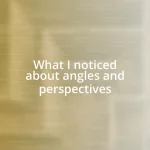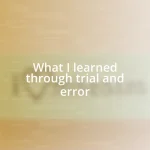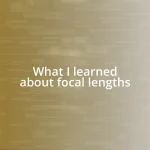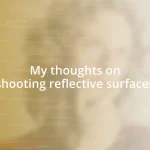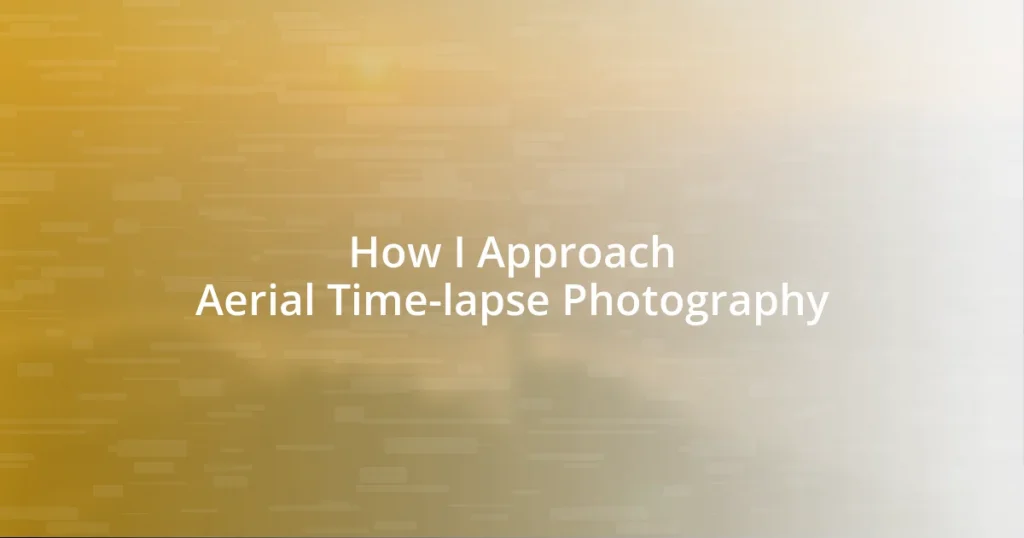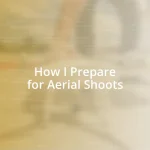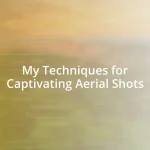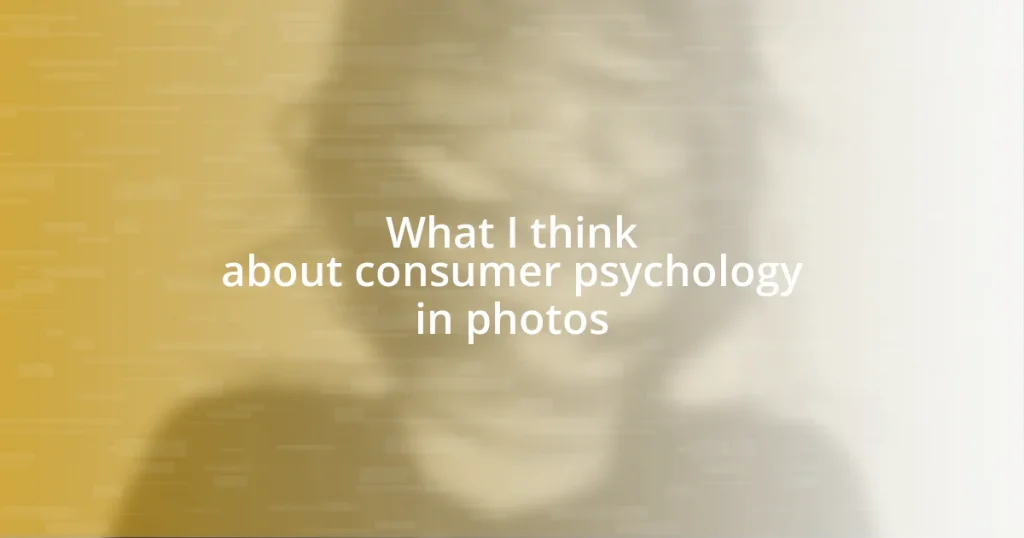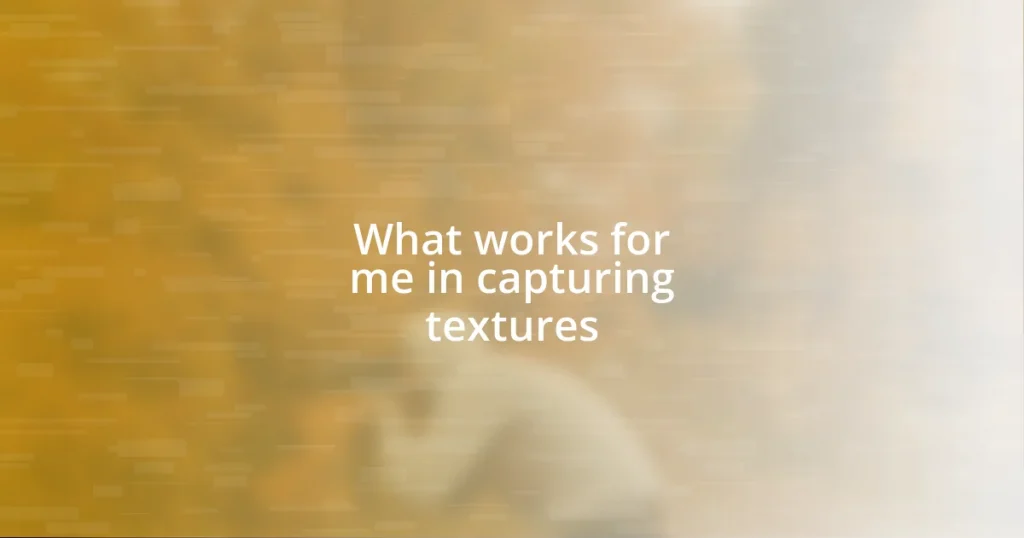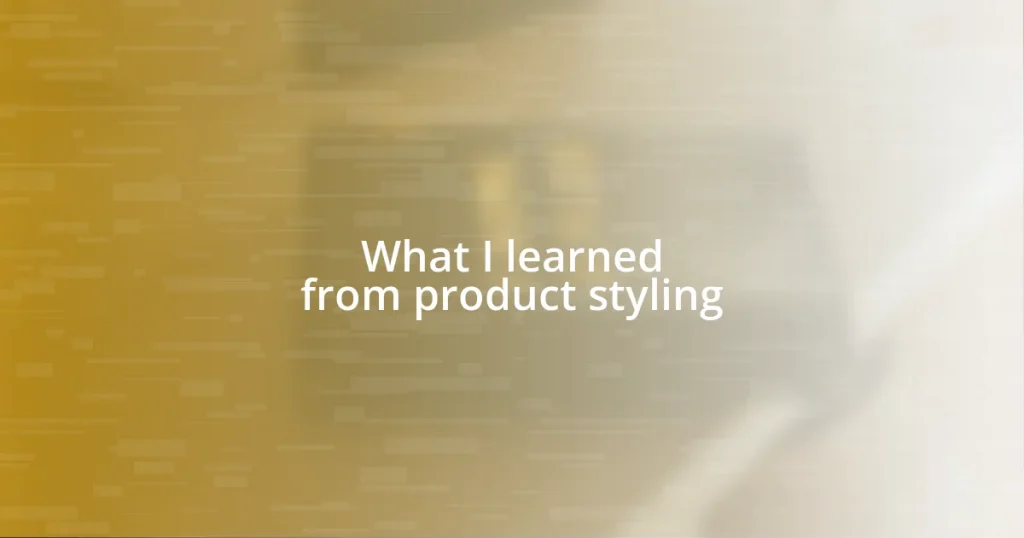Key takeaways:
- Proper equipment preparation and understanding key settings are crucial for successful aerial time-lapse photography.
- Choosing the right location and capturing dynamic movements enhance the visual storytelling and viewer engagement in time-lapse sequences.
- Post-processing techniques, including color grading and audio layering, significantly elevate the final presentation of time-lapse footage.

Understanding Aerial Time-lapse Photography
Aerial time-lapse photography captures the world from above, transforming the mundane into mesmerizing sequences of movement over time. When I first tried my hand at this, I was struck by how a simple sunset, viewed from a drone, could morph into a breathtaking canvas of colors that danced across the sky. Have you ever noticed how something as ordinary as a day turning into night can become extraordinary when seen from a different perspective?
This technique involves taking a series of photographs at set intervals, which are then stitched together to create a seamless visual narrative. I remember the thrill I felt when I compiled my first set of images into a video; the rush of adrenaline as I witnessed time itself unfold in ways I had never anticipated. It’s a brilliant way to showcase change, whether you’re focusing on natural landscapes or urban environments.
Understanding the underlying principles of aerial time-lapse photography is crucial for creating compelling footage. For instance, the choice of equipment—like camera settings and stabilization tools—can affect your final product immensely. I once made the mistake of neglecting to check my settings, resulting in a shaky video that didn’t do justice to the stunning scenery. How often do we overlook the basics only to learn the hard way?

Preparing Your Equipment For Success
Preparing your gear properly is key to successful aerial time-lapse photography. I always make a checklist to ensure I don’t forget any essential items before heading out. For instance, the first time I ventured into this, I realized halfway through my shoot that I had left my extra batteries behind. The sinking feeling in my stomach as the camera blinked low battery was a painful reminder of my oversight.
Additionally, it’s important to familiarize yourself with your equipment, especially if you’re using a drone. I once rushed into a shoot with new settings that I hadn’t fully explored, and it resulted in a series of images that lacked the quality I wanted. Now, I take time to test my drone and camera in various conditions to understand how they behave, allowing me to capture the best possible footage when it counts most.
Lastly, don’t underestimate the importance of having the right accessories. I learned the hard way that filters can make a huge difference in image quality and lighting, especially during sunsets or sunrises. Investing in a good quality ND filter transformed my footage from washed-out colors to vivid scenes that pop. It’s these little details that can elevate your work from average to exceptional.
| Equipment | Importance |
|---|---|
| Camera | Captures high-quality images |
| Drone | Provides aerial perspective |
| Extra Batteries | Ensures longer shooting time |
| ND Filters | Improves color depth and reduces glare |

Choosing The Right Location
Choosing the right location is a foundational step that can make or break your aerial time-lapse photography project. I’ve learned through trial and error that some spots hold potential while others simply fall flat. One of my most memorable experiences was capturing a vibrant autumn forest from above. The endless tapestry of colors blended together beautifully, which not only captured my imagination but also created a stunning visual narrative. It reminded me how the character of a location can enhance the mood and storytelling of your work.
When scouting locations, consider the following key aspects:
- Environmental Elements: Look for distinctive features such as rivers, mountains, or urban landscapes that add interest.
- Lighting Conditions: Early mornings and late afternoons often provide the best natural light, casting dramatic shadows and enhancing colors.
- Change Over Time: Select spots where changes are likely to happen, like traffic patterns in cityscapes or clouds moving over landscapes, to truly capture the essence of time-lapse.
- Accessibility and Safety: Ensure the location is safe and legal for drone operation; you don’t want to cut your shoot short because of restrictions.
- Personal Connection: Trust your instincts. Choose places that resonate with you emotionally, as your passion will reflect in the final piece.
Finding the perfect spot is essential and can turn your aerial time-lapse into a breathtaking experience.

Planning Your Time-lapse Sequence
When planning your time-lapse sequence, it’s essential to visualize the storytelling aspect of your shots. I often find myself sketching out my ideas beforehand, imagining how each moment will unfold. For example, I once plotted a sequence of the sun rising over a mountain range, and seeing it play out through the camera was both exhilarating and validating—I knew exactly how each shot would build upon the last.
As I prepare, I also consider the pacing of my sequence. Timing can change everything; too fast, and the essence of the scene gets lost; too slow, and viewers may lose interest. I remember a time when I filmed a bustling cityscape; I varied the intervals between shots, and the resulting footage showcased the vibrancy of the city, making it feel alive. Sometimes I even ask myself, how will my choices engage the audience? Each decision in timing is an opportunity to evoke emotions and capture attention.
Lastly, I make sure to factor in unexpected changes. The weather can be unpredictable, and I’ve had moments where a cloud bank unexpectedly rolled in and transformed my plans. Embracing spontaneity can lead to some of the most memorable captures. I learned to keep my mind open to these surprises, allowing the beauty of the moment to guide my lens. Planning is key, but flexibility can often become your greatest ally in crafting a compelling time-lapse sequence.

Capturing Stunning Aerial Footage
Capturing stunning aerial footage requires more than just a good camera; it’s about connecting with the environment beneath you. I remember a moment soaring over a coastal cliff at sunrise. The light danced off the ocean waves, and as I adjusted my angle, the scene transformed into a breathtaking painter’s palette. Isn’t it exhilarating when you find that perfect alignment of natural elements? It reminds us that photography is as much about the experience as it is about the equipment.
As I shoot, I always keep an eye on movement—both in the scenery and the drone. For instance, while filming a sprawling vineyard, I noticed the subtle shifts of the leaves as a breeze swept through. That small detail added a dynamic feel to the footage. Have you considered how incorporating movement, whether from nature or your drone, can elevate your work? It’s those slight nuances that can breathe life into a time-lapse, making the viewer feel like they’re part of the journey.
Finally, the importance of patience cannot be overstated. I once spent hours waiting for the perfect clouds to roll in over a mountain range. It was a test of will, but then, right on cue, those clouds turned a rich hue as the sun dipped below the horizon. The result was a time-lapse footage that left me in awe. I learned that waiting for the moment transforms a good shot into an extraordinary one. How often do we rush the process, forgetting that beauty unfolds in its own time? Embracing the waiting game often leads to the most rewarding captures.

Post-Processing Techniques For Time-lapse
Post-processing is where the magic of time-lapse really comes to life. I remember diving into editing after a long day of shooting a vibrant sunset over the ocean. As I began to stitch together the frames, I couldn’t help but feel a rush of excitement—how color grading can completely change the mood of the footage! I like to experiment with different tones and contrasts, often recalling a moment when I pushed the colors to evoke the warmth of that golden hour, making viewers almost feel that gentle ocean breeze.
One technique I often employ is to speed up the footage to enhance the sense of movement. For instance, while editing a time-lapse of a busy farmers’ market, I cranked up the speed to highlight the hustle and bustle. This added a lively pulse to the sequence. Have you ever considered how altering the playback speed can transform a scene? It’s all about making a choice that amplifies the viewer’s experience—drawing them in, making them feel the energy.
I also pay close attention to audio layering in my post-processing. After all, sound has the power to evoke feelings just as much as visuals do. There’s a particular time-lapse I worked on, where the gentle rustle of leaves complemented the visuals perfectly. I added that sound in post to amplify the connection with nature. Does your work reflect soundscapes that resonate with the imagery? Balancing engaging visuals with the right audio can elevate a simple time-lapse into an immersive experience that truly captivates the audience.

Sharing Your Work Effectively
When it comes to sharing your aerial time-lapse photography, selecting the right platform is crucial. I’ve found that social media channels like Instagram or YouTube are fantastic for reaching an audience that appreciates visual storytelling. I remember posting a vibrant time-lapse of a sunrise glazing over a mountain range on Instagram, and the response was overwhelming. It made me realize how important it is to hone in on communities that resonate with your work. Have you thought about where your audience spends their time? Understanding your platform can significantly impact your engagement with viewers.
Beyond the platform, storytelling plays a pivotal role in how your work is perceived. Each time-lapse I share tells a story—whether it’s the slow change of seasons in a forest or the rhythm of the tides at the beach. There was this one particular project where I documented the transformation of a busy cityscape from dawn to dusk. As I shared snippets, I included captions that drew the audience into the narrative. It was gratifying to see viewers connect emotionally with the journey. How do you add context to your visuals? Crafting a narrative around your work can turn a stunning visual into a powerful connection.
Finally, don’t underestimate the impact of collaboration. I remember collaborating with fellow photographers for a group exhibition. Each artist brought a unique perspective, and together, we created an immersive experience that celebrated aerial photography. Sharing your work alongside others not only enriches your portfolio but also allows you to reach new audiences. Have you considered collaborating with fellow creatives? Together, you can create something that’s larger than the sum of its parts, showcasing diverse talents while expanding your reach.



